.
Apple strudel is one of my favourite sweet dishes and although I’ve made lots of them myself and have eaten even more in restaurants and cafés, my mum’s apple strudel is still the best I’ve ever tasted. She always made two baking trays of strudel for our large family, plus two generous cans of vanilla sauce. What shall I say? There never were any leftovers! It tasted too good to leave a single crumb on the plate (especially for my brothers who always ate like there was no tomorrow).
When I tried to make my first strudel, it was, well, not a disaster but not a pretty sight either. The dough was too thick in some parts and so thin in others that it tore and had holes in it. It tasted good, however, and that kept me going. Since then I’ve gathered a lot of experience in making strudel dough and pulling it without tearing – although the occasional hole may form.
If you’ve ever wanted to make an apple strudel by yourself but have shrunk back from pulling the strudel dough, here’s your chance to learn how to do it. Some basic ingredients and a few knacks to observe are all you need for a delicious strudel dough for all kinds of fillings!
Strudel basics
What makes a strudel into a really good strudel?
A good strudel has a beautiful colour. It is usually golden yellow, but it can also be almost black, for example, when the dough is coloured with cocoa or sepia.
The outer layers should be crispy and the strudel should look good when cut into pieces.
Nevertheless, the most important thing about a strudel is the filling which may be sweet or savoury.
What kinds of strudel doughs are there and what do you use them for?
The classic strudel dough is a pulled dough which refers to the fact that you have to pull out the dough very thinly before you spread the filling on it. Pulled strudel dough is typically used for apple or vegetable strudel.
Other strudel doughs include for example puff pastry, shortcrust, yeast dough, curd cheese dough and even pancake dough.
In this post, we’re gonna learn to make a classic Bavarian and an Austrian pulled strudel dough.
Basic knowledge about pulled strudel dough
Most beginners are not afraid of the simple kneading of the dough but the “pulling” part. When pulled properly, the dough should be very thin (some say you should be able to read a newspaper through it) and it shouldn’t tear.
How do we manage that?
By mixing flour with water. The flour proteins (gluten) build a network with the water and form a rubber-like, elastic mass. This network enables us to pull the dough very thinly without tearing it. The longer the dough can rest, the better its capacity to be pulled. The dough should rest for at least half an hour, but it’s better to let it rest for 1 – 2 hours or even overnight in the fridge.
If you want to use the dough now, it still needs to rest for about 30 minutes but my mum always used to cover it with a hot metal bowl: she poured hot water into a metal bowl that was slightly smaller than the dough bowl opening, drained off the water and dried the bowl. Then she put the bowl upside down over the dough.
Ingredients like oil, vinegar and egg also enhance the dough’s elasticity.
It’s also important to knead the dough thoroughly as kneading intensifies the protein-water-reaction. When you work the dough for some time you’ll realize that it starts to feel elastic, smooth, even and not in the least sticky.
What flour should you use?
As you heard before, the proteins (= gluten) in the flour are important. The higher the protein content, the more elastic the dough.
Worldwide there are different flour types. What we in Germany know as “Type 550” (wheat flour) is the “all-purpose” flour in English-speaking countries. Flours of a higher type like bread flour or high-gluten flour are also suitable. The same goes for spelt flour.
No matter what flour you use, however, it’s important to observe the water-flour ratio. After kneading the dough should be smooth, elastic and a little bit moist but not sticky.
Storage
Strudel dough can be kept in the fridge for about 2 days. It may change its colour to a light grey but that’s quite normal and will lighten when kneaded. Always let the dough reach room temperature before processing it further.
You can even freeze raw strudel dough and let it thaw overnight before processing it.
If you want to freeze a whole (or parts of a) strudel, put the (raw or baked) strudel onto a tray with baking paper and put it into the freezer until it’s completely frozen. Afterwards, put it into a container or freezer bag.
How to fill a strudel
There are two different methods to fill a strudel.
1) Put the filling on the first third of the dough
With this method, it’s important to have a thin strudel dough as you have several layers of it on the outside when it’s baked. If the dough were too thick, the outer layers would be hard and you couldn’t cut them well.
Always leave out the edges which will be folded inwards before rolling the strudel.
This method is recommended.
- when you have a relatively moist and hardly compact filling
- when the filling contains a good amount of eggs that will rise during baking
- when you want to get more crispy strudel dough instead of only one layer
- when you want to make sure that the strudel dough won’t tear
- when you want to make an elegant strudel that can also be presented standing
- when you want to use store-bought dough like filo, yufka or strudel dough. Brush each layer with melted butter before adding another dough leaf (not more than 4 – 6 leaves)
2) Put the filling on the whole dough
For this method, you can use thin and (even better) thicker doughs which stay more compact during baking and don’t tear as easily as thin doughs. If your filling contains eggs or beaten egg whites, the risk of tearing is higher during baking as the filling expands. Just make sure to roll the strudel not too tightly.
Leave out the edges before rolling the strudel.
This method is recommended
- when you have a relatively compact filling mass
- when you prefer thick strudel dough
- when you want to fill the strudel the classic way
Recipe: Bavarian strudel dough
Ingredients:
300g flour (all-purpose)
1 tbsp oil
1 tbsp vinegar (white, apple or quince vinegar)
1 pinch of salt
1 egg
125 ml (1/8 l) lukewarm water
oil for brushing
Instructions:
Sieve the flour into a bowl, add the other ingredients and knead it all into a smooth dough.
Brush the dough with oil, put it back into the bowl, cover the bowl with cling film and let the dough rest for at least 30 minutes, the longer the better. If you want to use it right away, cover it with a hotly rinsed and dried metal bowl for 30 minutes.
This dough is traditionally pulled very thinly.
Strudel dough – step-by-step instructions
1. Put the flour, egg/vinegar, salt and oil into a bowl and add the lukewarm water

2. Mix the ingredients thoroughly and knead the dough…
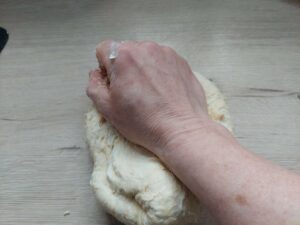
3…. until it’s smooth. Form the dough into a ball, brush it with oil, put it back in the bowl that you cover with cling film. Let it rest for at least 30 minutes.

4. Dust a kitchen towel with flour and roll out the dough with a rolling pin.
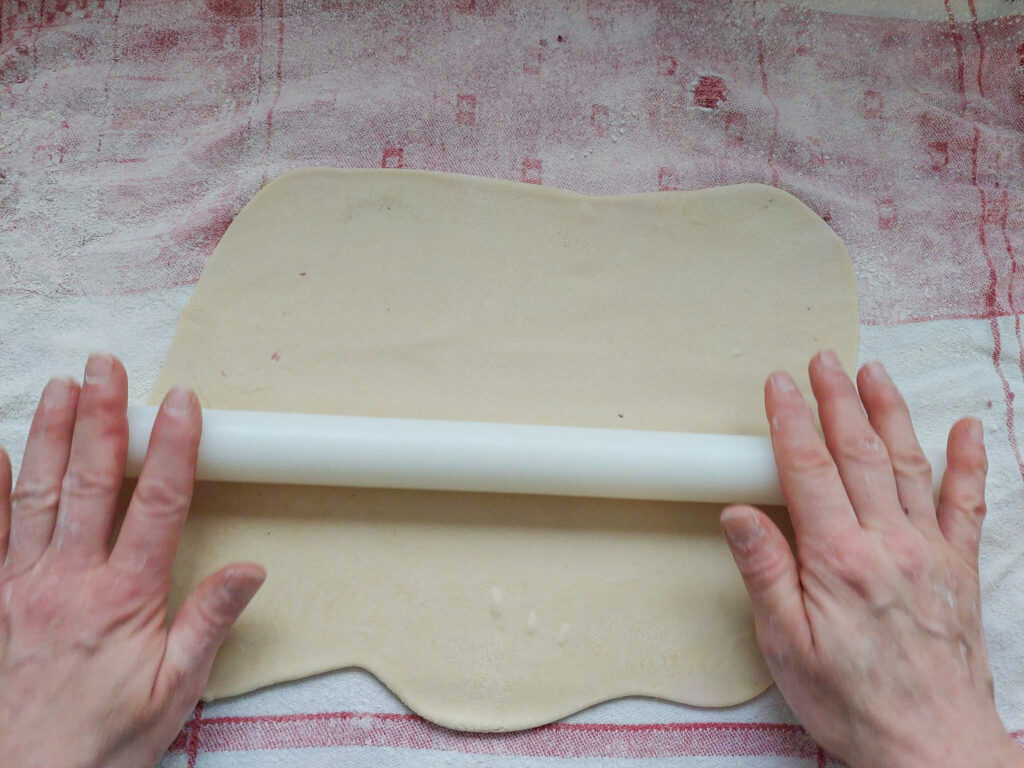
5. Start pulling the dough carefully at the edges with your fingers.
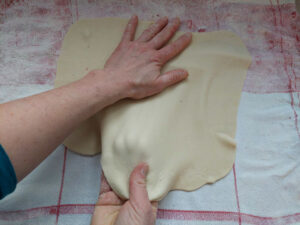
6. Pull the dough with the back of your hand while holding it with the other hand.
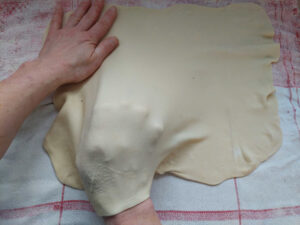
7. Pull the dough thinly into a rectangle. You should see slightly through it.
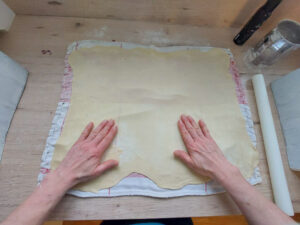
8. Either spread the filling on one-third of the dough…
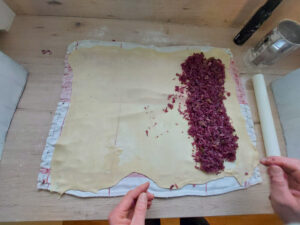
9. … or across the whole dough. Leave out the edges.
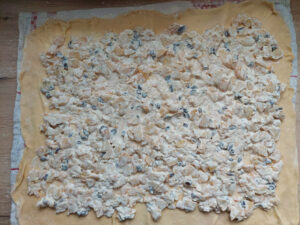
10. No matter how you placed the filling, fold in the edges.
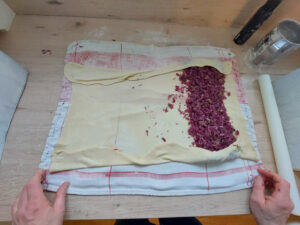
11. Gently roll the strudel with the help of the towel.
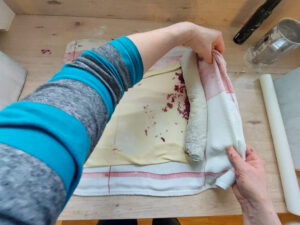
12. Prick the strudel with a pin so that moisture can evaporate during baking.
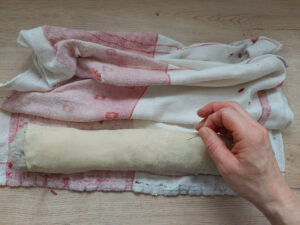
13. Bake the strudel at 180 °C (350 °F) for 35 – 45 minutes and let it cool down a bit before serving.

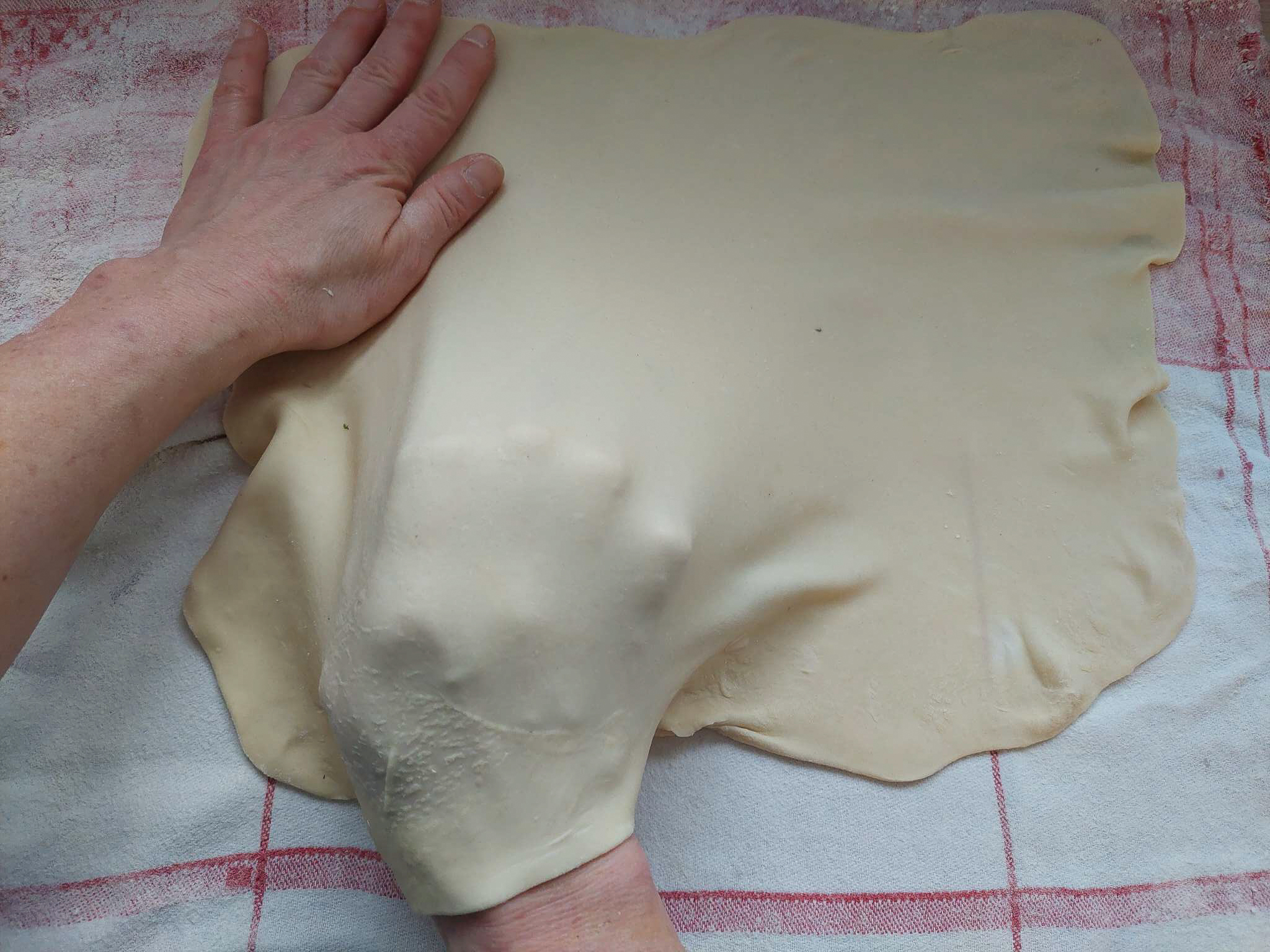
Bavarian Strudel Dough
Ingredients
Method
- Put the flour, egg/vinegar, salt and oil into a bowl and add the lukewarm water.
- Mix the ingredients thoroughly and knead the dough until it's smooth.
- Form the dough into a ball, brush it with oil and cover it with cling film. Let it rest for at least 30 minutes.
- Dust a kitchen towel with flour and roll out the dough with a rolling pin.
- Start pulling the dough carefully at the edges with your fingers.
- Pull the dough with the back of your hand while holding it with the other hand.
- Pull the dough thinly into a rectangle. You should see slightly through it.
- Either spread the filling on one-third of the dough or across the whole dough. Leave the edges out.
- No matter how you placed the filling, fold in the edges.
- Gently roll the strudel with the help of the towel.
- Prick the strudel with a pin so that moisture can evaporate during baking.
- Bake the strudel at 180 °C (350 °F) for 35 - 45 minutes and let it cool down a bit before serving.
Tips and tricks for a perfect strudel
- Dust the kitchen towel with flour before you roll the dough out with a rolling pin. Remove rings, bracelets, watches etc., they only cause holes. Always pull with the whole (back of the) hand and work slowly and relaxed.
- Before rolling, fold in the short edges. That way no filling can spill.
- Make sure that the seams of your strudel are tightly closed so that no filling gets out during baking.
- If your filling contains eggs, it’ll rise during baking and will need more room. Don’t roll the strudel too tightly.
- Prick the strudel with a pin before baking so that moisture can evaporate and the dough won’t tear.
- If you brush the strudel with egg yolk before baking, it gets a beautiful colour and becomes crispy.
- Brushing with olive oil or butter also makes the strudel crispy.
- If the dough has become too hard after baking, cover the strudel with a cloth or brush it lightly with salt or sugar water and let it cool. It becomes softer.
Troubleshooting
The strudel dough is too moist.
The right ratio between flour and water is essential for a strudel dough which should be smooth and elastic, slightly moist but not sticky. If the dough is too moist, knead in some flour, a little at a time.
The strudel dough is too dry.
If the dough tears when kneaded, it usually is too dry. Wet your hands repeatedly when kneading and thus moisten up the dough.
What to do when strudel dough tears
You did everything right but your dough has torn nevertheless? The flour may be the reason. Flour is a natural product and the protein (gluten) content can vary.
However, it’s no drama if your dough has torn. That has happened (and still does) to everyone who has ever done a strudel. There are, however, a few things you can do:
1) Most tears and holes aren’t large. Just press the dough together with your fingers and close the hole.
2) Depending on where the holes have formed, you may not see them when the strudel has been rolled up. “Mending” won’t be necessary then.
3) If there are really many holes (think Swiss cheese) you could put the dough together, knead it through and try to pull it out again. Or you cut off parts of the edges and stick them onto the holes. You could even cut off dough strips and decorate the wrapped-up strudel creatively. Remember, the most important part of the strudel is the filling!
Making strudel dough is very easy and pulling it thinly without tearing is also not rocket science. If you’re a newbie to strudel making, I suggest starting with the Bavarian strudel dough as it needn’t be pulled out too thin and is more forgiving. Make sure that you observe each step and you’ll be on your way to becoming a strudel master before you can say “apple strudel”!

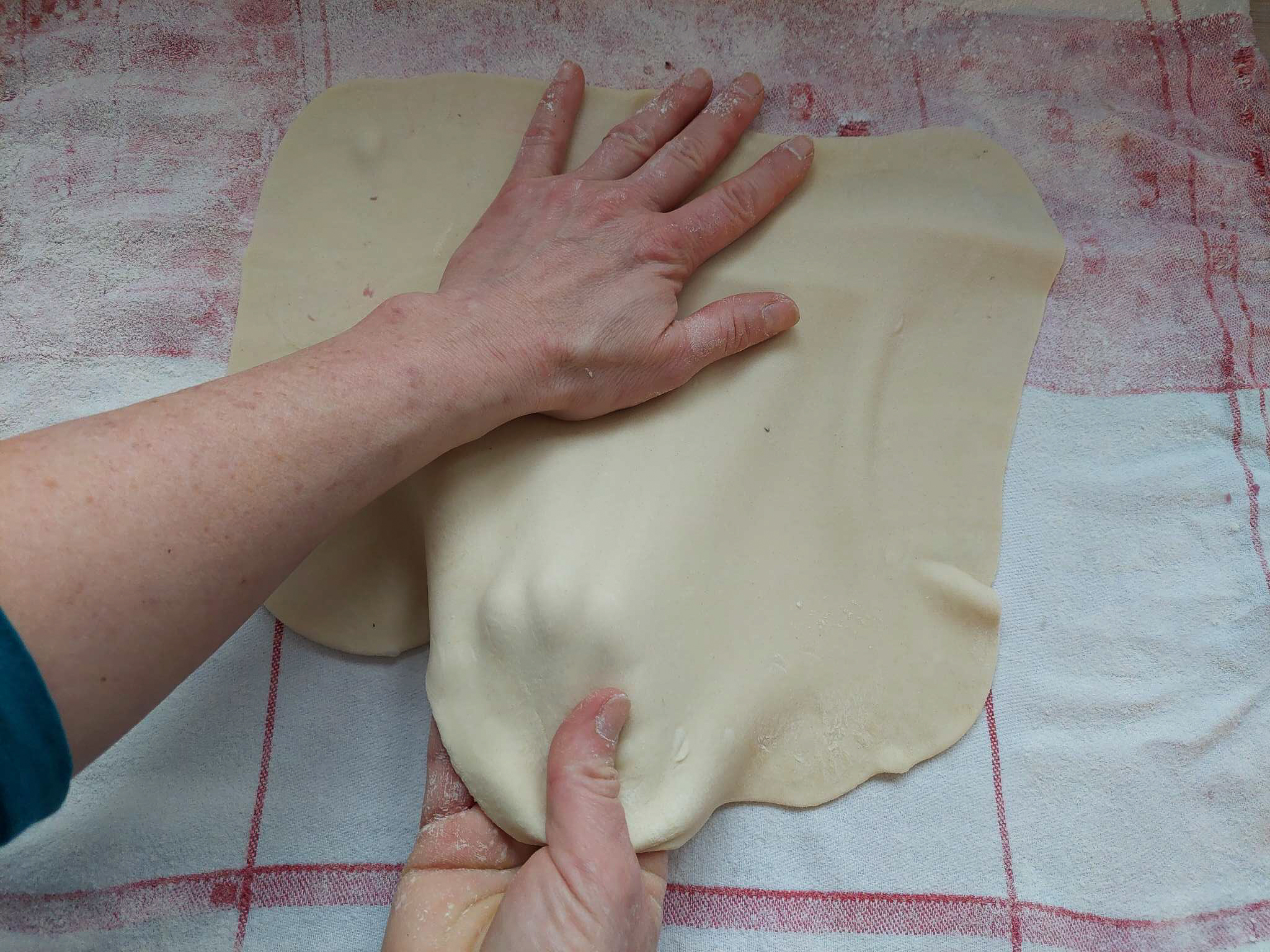
0 Comments